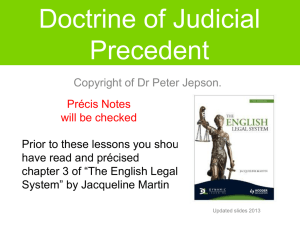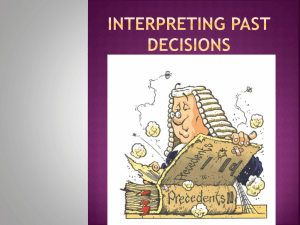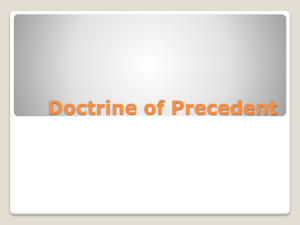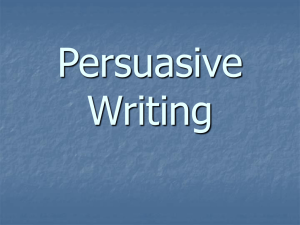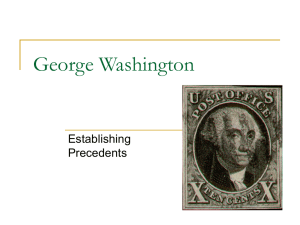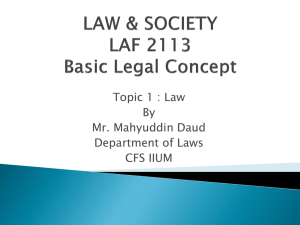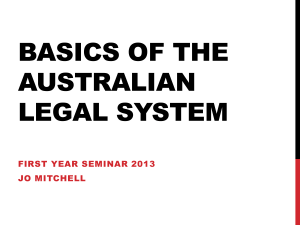Precedent and Statutory Interpretation.
advertisement
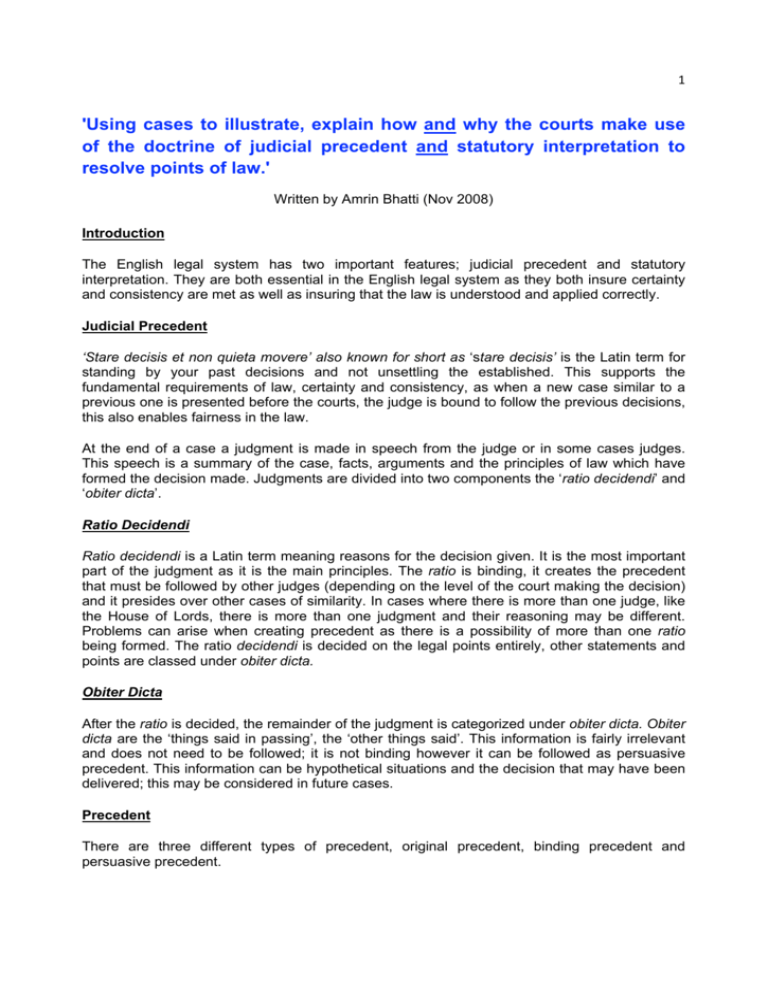
! "! 'Using cases to illustrate, explain how and why the courts make use of the doctrine of judicial precedent and statutory interpretation to resolve points of law.' Written by Amrin Bhatti (Nov 2008) Introduction! The English legal system has two important features; judicial precedent and statutory interpretation. They are both essential in the English legal system as they both insure certainty and consistency are met as well as insuring that the law is understood and applied correctly. Judicial Precedent ‘Stare decisis et non quieta movere’ also known for short as ‘stare decisis’ is the Latin term for standing by your past decisions and not unsettling the established. This supports the fundamental requirements of law, certainty and consistency, as when a new case similar to a previous one is presented before the courts, the judge is bound to follow the previous decisions, this also enables fairness in the law. At the end of a case a judgment is made in speech from the judge or in some cases judges. This speech is a summary of the case, facts, arguments and the principles of law which have formed the decision made. Judgments are divided into two components the ‘ratio decidendi’ and ‘obiter dicta’. Ratio Decidendi Ratio decidendi is a Latin term meaning reasons for the decision given. It is the most important part of the judgment as it is the main principles. The ratio is binding, it creates the precedent that must be followed by other judges (depending on the level of the court making the decision) and it presides over other cases of similarity. In cases where there is more than one judge, like the House of Lords, there is more than one judgment and their reasoning may be different. Problems can arise when creating precedent as there is a possibility of more than one ratio being formed. The ratio decidendi is decided on the legal points entirely, other statements and points are classed under obiter dicta. Obiter Dicta After the ratio is decided, the remainder of the judgment is categorized under obiter dicta. Obiter dicta are the ‘things said in passing’, the ‘other things said’. This information is fairly irrelevant and does not need to be followed; it is not binding however it can be followed as persuasive precedent. This information can be hypothetical situations and the decision that may have been delivered; this may be considered in future cases. Precedent There are three different types of precedent, original precedent, binding precedent and persuasive precedent. ! #! Original precedent is the first precedent; the first judgment established which is to then be followed by the courts below in the hierarchy. When forming a new precedent judges may look at other cases with similar issues to aid their decision, this is known as ‘reasoning by analogy’. Hunter and others v Canary Whalf LTD and London Docklands Development Corporation (1995) is an example of reasoning by analogy. The claimant, Hunter, believed the building, Whalf tower, was causing an interference with the television reception at her home and was claiming damages along with others. Lord Justice Pill used a previous case which he felt held similar facts which would constitute the decision of the Hunter case. He used the Aldred Case (1611) which stated that a view was a delight and not a necessity and a view was similar to a television signal, hence Hunter was unsuccessful in her claim. Judicial precedent enables interpretations and adaptations to law. Original precedent perceives judges as a law-making body, this contradicts the purpose of judges, as they are not to create law but to apply and enforce it. Binding precedent is the precedent from an earlier case which must be followed, even if the judge opposes the decision and the legal principles of the previous case; he is still bound by it. Binding precedent is only applicable if the precedent was created in a higher, or possibly the same court in the hierarchy, for example; the Magistrates court is bound by the Court of Appeal and the Court of Appeal is bound by itself. Furthermore, European law is supreme over English law and therefore the European Court of Justice is binding over the courts of England and Wales. Persuasive precedent is precedent that is not binding on courts. Judges have the option to choose whether or not they wish to follow persuasive precedent as a guideline in another case. Persuasive Precedent comes from many different sources. Persuasive precedent can come from courts lower in the hierarchy; this can be seen in R v R (1991)), the House of Lords agreed with and followed the same reasoning as the Court of Appeal in deciding that a man could be guilty of raping his wife. The House of Lord was persuaded to follow the precedent of the Court of Appeal. The Judicial Committee of the Privy Council is not part of the hierarchy of courts therefore it is not binding, however since many of its judges are also members of the House of Lords, their judgments are treated with respect and may often be followed. In R v Mohammed (2005) and R v James and Karimi (2006) the Court of Appeal followed a decision made by the Privy Council in R v Holley (2005). They were persuaded to follow it, however it is to be noted that the precedent created by the House of Lords in R v Smith (2000) should have been followed in these cases as it is binding unlike the Privy Council. Statements made from obiter dicta may also be followed as persuasive precedent, for instance in R v Howe (1987), an obiter statement ruled that duress could not be used as a defence for someone charged with attempted murder. The Court of Appeal followed the ruling as persuasive precedent in R v Gotts (1992). A dissenting judge, (a judge that disagrees), would explain his reasoning for disagreeing, if the case where to go before the House of Lords, it is possible that the House of Lords may be persuaded to follow the reasoning of the dissenting judge and can base their decision upon it. ! $! Decisions from other countries may also be taken into account as persuasive precedent for example, countries such as Canada, Australia and New Zealand, all of whom have the same ideas of common law. Also decisions made by the European Court of Human Rights may be taken into consideration. The House of Lords and the Practice Statement The highest court in the English Legal system is the House of Lords. Until 1966 the House of Lords was bound by its own previous decisions to ensure certainty and consistency, which was regarded as the most important feature of law. In London Street Tramways v London County Council (1898) the Lord Chancellor issued the Practice Statement, within it the House of Lords emphasized the importance and necessity of having to follow past decisions however, when decisions are made in error (per incuriam) the House of Lords is no longer bound and is able to change, amend and correct the error in accordance to society, social conditions or opinions. Previously changes and corrections could not be made and were prohibited, change could only occur through Parliament. Before 1967, a person could not be guilty of murder if they did not intend to cause death or serious injury or that their actions would have such an effect. This loophole in the law meant that murderers could escape without conviction. This was changed in 1967 in the Criminal Justice Act. It can take a long time for Parliament to change the law, if the House of Lords was able to do it, then change would occur when necessary and with more haste. The first case in which the Practice Statement was put into effect was Conway v Rimmer (1968). The first major use occurred in Herrington v British Railways Board (1972) which was based on the original precedent of Addie v Dumbreck (1929). It was decided that the social and physical conditions between then and now had changed and so the law should change too. Avoiding Judicial Precedent There are three ways in which judicial precedent can be avoided, distinguishing, overruling and reversing. Distinguishing is a method used by judges to avoid following past decisions. A judge would compare the facts of the previous precedent and the present case, if there is a significant difference, then the judge is not bound by the previous case. An example of this would be Balfour v Balfour (1919) and Merritt v Merritt (1971). Both cases were wives making claims against their husbands for breach of contract. In Balfour the claim did not succeed because there was no intention to create legal relations. In Merritt the claim was successful, as the agreement was made after they had separated and in writing, meaning it was not just a domestic arrangement like in Balfour but a legally enforceable contract. Overruling is when a court in a later case decides that the legal rule in the earlier case was wrong. Only a higher court can overrule a decision made by a lower court. A lower court cannot overrule a decision of a higher court. In Pepper V Hart (1993), the House of Lords ruled that Hansard could be consulted when trying to decide what certain words in an Act of Parliament meant. Thus the earlier case of Davies v Johnson (1979) was overruled as it held that Hansard could not be consulted. ! %! Reversing is when the same case is on appeal to a higher court in the hierarchy, and the higher court overturns the decision of the lower court. For example, a decision of the High Court can be overturned by the Court of Appeal as seen in the Shabina Begum Case (2004). Statutory Interpretation Sometimes a case can come before a court and there is dispute over the meaning of an Act of Parliament or even a word. Statutory interpretation aids judges in understanding and applying the law which is causing dispute. Issues can arise for many reasons, in the Dangerous Dog Act (1991), the word “breed” created dispute as it was a broad term and people did not understand what was implied by it. Statutory interpretation can help give a definite meaning to it. Ambiguity is also a problem that could occur. When a word has two or more meanings it is hard to know which definition is the one to be followed. This can be an error made by drafting which is also a predicament that can occur or when an Act had been amended repeatedly. New Developments can occur making an old Act of Parliament incompatible. This happened in Royal College of Nursing v DHSS (1981). Medical science and methods had changed since the Abortion Act of 1967. Also language can change over time and so can meanings of words as seen in Cheeseman v DPP (1990). Statutory interpretation is necessary as it helps to prevent problems as listed above from occurring so it can be understood and applied correctly. There are four approaches a judge can use in statutory interpretation, the literal rule, the golden rule, the mischief rule and the purposive approach. The Literal Rule The literal rule is the easiest and frequently used in statutory interpretation, it means that judges will rule words their plain, ordinary or easiest meaning even when the meaning can create an absurd result. In R v Judge of the City of London Court (1892), Lord Esher stated that “If the words of an act are clear then you must follow them even though they lead to a manifest of absurdity. The court has nothing to do with the question whether the legislature has committed an absurdity.” The biggest problem which can arise from the literal rule is that it does in fact lead to decisions of absurdity. In Whiteley v Chappell (1868), the defendant impersonated a dead person and used their name to vote. Following the literal rule the defendant was found not guilty as a dead person is not ‘entitled to vote’. The literal rule created an absurd verdict. In London & North Eastern Railway Co. v Berriman (1946), a railway worker died as the Railway Company did not comply with regulations under the Fatal Accidents Act which said they should provide a lookout for men working on or near the tracks. In the Act the words ‘relaying’ and ‘repairing’ in a literal context and stated that the worker was maintain the line, so his widow’s claim failed and compensation was not received. This led to a harsh decision. ! &! Professor Michael Zander has criticized the literal rule for being too mechanical and divorced from the realities of the use of language. It has also been criticized as being too rigid and not allowing flexibility when needed. The Golden Rule The golden rule holds many similarities to the literal rule however it helps to atop absurd meanings and decisions being made. It follows the literal meaning but when absurdity is clear and there are other meanings for the word, phrase or Act, a judge can distinguish which meaning they wish to follow to eliminate absurdity. There are two ways in which the golden rule can be used, the narrow application and the wider application. The narrow application was used in R v Allen (1872) the word “marry” caused confusion. Under s. 57 of the Offences Against the Person Act 1891, it was stated that it was an offence to ‘marry’ whilst the original spouse was still alive (and there had been no divorce). The word ‘marry’ can have two meanings, to become legally married or to when a person takes part or ‘goes through’ a ceremony of marriage. Allen claimed he could not be guilty as he could not ‘legally marry’ someone else as he was already married and not divorced. The court used the second meaning to avoid an absurd result which would mean that no one could be guilty of bigamy. The wider application was used in R v Sigsworth (1935), a mother had not written a will, so her son would automatically inherit all that was hers under the Administration of Justice Act 1925. The son murdered his mother to claim her fortune, although the wording of the Act was correct and there was no ambiguity, the court refused to allow the murderer to be rewarded for his crimes. The golden rule was used to prevent the son from inheriting his mother’s fortune and creating a repugnant situation. The Mischief Rule The mischief rule gives a judge more discretion than the previous rules. The definition of it comes from the Heydon case (1584). It stated four points to be considered in deciding the meaning of the statute. This rule means a judge would look at what the law was before the Act was passed to discover what gap or ‘mischief’ was intended to be covered by the Act. In Smith v Hughes (1960) the mischief rule was applied. Under the Street Offences Act 1958 it declared that ‘it shall be an offence for a common prostitute to loiter or solicit in a street or public place for the purpose of prostitution’. The defendant stated that they were inside a building therefore they were not on a street. Despite the wording of ‘street’, they were found guilty. The rule established that the Act was created to prevent prostitution. In the Royal College of Nursing v DHSS (1981), the wording of the Abortion Act did not comply with changes in society by 1981, it stated that a abortion could only be carried out by a doctor, however it can now be carried out without surgery. This meant nurses could carry it out, however the Act permitted them from doing so. The case was brought before the House of Lords and it was decided that it was illegal. The mischief rule established that the Act was designed to make sure abortions were carried out safely and correctly by professionals. The Purposive Approach ! '! The purposive approach is used by judges to look at what they believe Parliament meant by the Act and what it was to achieve. Lord Denning stated that “We sit here to find out the intention of Parliament and carry it out, and we do this better by filling in the gaps and making sense of the enactment than by opening it up to destructive analysis.” However it was opposed by Lord Scarmen and others as he stated “If Parliament says one thing but means another, it is not, under the historic principles if the common law, for the courts to correct it. The general principle must surely be acceptable in our society. We are to be governed not by Parliament’s intentions but by Parliament’s enactments.” The purposive approach gives judges more discretion in their interpretation of an Act and it is arguable that they should not have such power as their duty is to apply the law and not create it. European countries favour this type of interpretation, since Britain’s membership of the EU, the purposive approach has played a bigger part in the English legal system. It is also used in European law as there are so many languages it needs to be translated in that it cannot possibly be reworded exactly and precisely as when first created. In R (Quintavelle) v Secretary of State for Health (2003) the House of Lords used the purposive approach in deciding that organisms created by cell nuclear replacement came within the definition of “embryo” in the Human Embryology and Fertilisation 1990. Conclusion It is evidently clear that the doctrine of judicial precedent and statutory interpretation is crucially vital in the English legal system. It enables law to be applied correctly and fairly while maintaining certainty and consistency. There is a little room for some flexibility so that judges can avoid previous decisions when a necessary, as well as making adaptation to suit today’s needs. Overall judicial precedent and statutory interpretation are both effective.
